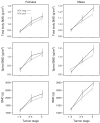Total body and spinal bone mineral density across Tanner stage in perinatally HIV-infected and uninfected children and youth in PACTG 1045
- PMID: 20168204
- PMCID: PMC3154736
- DOI: 10.1097/QAD.0b013e328336095d
Total body and spinal bone mineral density across Tanner stage in perinatally HIV-infected and uninfected children and youth in PACTG 1045
Abstract
Objective: To characterize total body bone mineral content (BMC) and total body and spinal bone mineral density (BMD) in perinatally HIV-infected and uninfected children/youth across puberty.
Design: HIV-infected (7-24 years) were randomly selected from six strata based on Tanner stage/protease inhibitor use. HIV-uninfected were frequency-matched by Tanner group and sociodemographic background to the HIV-infected.
Methods: Dual-energy X-ray absorptiometry (DXA) measured BMC and BMD. Linear regression models tested differences in bone outcomes by HIV and the interaction of HIV by Tanner group (1-2, 3-4, 5). Models were performed separately by sex and adjusted for DXA scanner, race/ethnicity, height, age and lean body mass.
Results: HIV-infected (N = 236) and uninfected (N = 143) were comparable on sex and race/ethnicity. HIV-infected were slightly older (median 12.6 versus 11.9 years). In adjusted models, HIV-infected males had significantly lower total body BMC and total body and spinal BMD at Tanner 5, lower BMC at Tanner 3-4 and similar BMC and BMD at Tanner 1-2, compared to HIV-uninfected males. HIV-infected and uninfected girls did not differ significantly on any bone outcome, but there was a marginally significant interaction of HIV and Tanner group for spinal BMD. Kaletra/ritonavir was associated with lower BMC and total body BMD and nevirapine was associated with higher spinal BMD in a model with all HIV-infected.
Conclusions: Perinatally HIV-infected males showed more evidence of lower bone density especially in the final stage of pubertal development than HIV-infected girls and they may be at increased risk for bone disease during adulthood.
Figures
References
-
- Arpadi SM, Horlick M, Thornton J, Cuff PA, Wang J, Kotler DP. Bone mineral content is lower in prepubertal HIV-infected children. J Acquir Immune Defic Syndr. 2002;29:450–454. - PubMed
-
- O'Brien KO, Razavi M, Henderson RA, Caballero B, Ellis KJ. Bone mineral content in girls perinatally infected with HIV. Am J Clin Nutr. 2001;73:821–826. - PubMed
-
- Mora S, Zamproni I, Beccio S, Bianchi R, Giacomet V, Vigano A. Longitudinal changes of bone mineral density and metabolism in antiretroviral-treated human immunodeficiency virus-infected children. J Clin Endocrinol Metab. 2004;89:24–28. - PubMed
-
- Jacobson DL, Spiegelman D, Duggan C, Weinberg GA, Bechard L, Furuta L, et al. Predictors of bone mineral density in human immunodeficiency virus-1 infected children. J Pediatr Gastroenterol Nutr. 2005;41:339–346. - PubMed
-
- Amorosa V, Tebas P. Bone disease and HIV infection. Clin Infect Dis. 2006;42:108–114. - PubMed
Publication types
MeSH terms
Grants and funding
- 5U01A1068616/PHS HHS/United States
- 1 U01 AI068632-01/AI/NIAID NIH HHS/United States
- P30 DK040561/DK/NIDDK NIH HHS/United States
- HHSN267200800001G/DK/NIDDK NIH HHS/United States
- UM1 AI068632/AI/NIAID NIH HHS/United States
- M01 RR001271/RR/NCRR NIH HHS/United States
- U01 AI068616/AI/NIAID NIH HHS/United States
- HHSN267200800001C/HD/NICHD NIH HHS/United States
- U01 AI041110/AI/NIAID NIH HHS/United States
- N01-DK-9-001/HHSN267200800001C/DK/NIDDK NIH HHS/United States
- AI068632/AI/NIAID NIH HHS/United States
- M01 RR000069/RR/NCRR NIH HHS/United States
- U01 AI068632/AI/NIAID NIH HHS/United States
- #1 U01 AI068616/AI/NIAID NIH HHS/United States
- #5 U01 AI41110/AI/NIAID NIH HHS/United States
LinkOut - more resources
Full Text Sources
Medical


